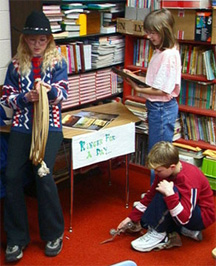
|
|
|
Activities
|
Extensions
|
|
|
|
Background
|
Related
Links
|
Development
of learning stations enhances comprehension by utilizing a hands-on
approach to the learning process.
Teachers
may create learning stations, providing students the opportunity
to recreate a real life situation. Stations enhance learning by
‘virtually’ allowing students to apply skills in practical
applications, thereby making the educational activity more relevant.
 |
 |
To
develop a hands-on lesson, teachers incorporate life experiences
and practical application of the skills needed to solve the
problem being replicated in the station. Whenever possible,
the station should be organized with the materials that would
potentially be used in a real life situation. Example: a bicycle
set on a stationary trainer to simulate overland travel. The
lesson objective has students figuring fitness levels before/after
a two -minute bicycle ‘ride’.
In
whole group instruction, individual groups of two or three
may participate at the station, conducting the activity while
the rest of the class is involved in teacher guided instruction
pertaining to the activity. The rest of the class rotates
by groups until every student has had the opportunity to complete
the activity.
The use of several stations simultaneously
requires a bit more planning, however is an effective teaching
method. Student groups of two, with as many as five participants,
allow on task learning by the group. Groups should be divided
by an assortment of ability and learning levels. Close monitoring
by the teacher will control dominate student behaviors so
that each student within the group will be a contributing
member, taking ownership of the project.
|
Time
set aside for student participation at each station will be determined
by the number in each group and the number of stations that each
group will visit. Preferably, students will rotate every twenty
minutes. This encourages the group to complete each task, document
information as needed, then be ready to move on when time is called.
Student
groups facilitate the learning process by allowing students to process
feedback from their peers, while providing a secure environment
for student feedback within the group. Discussions center around
everyone being on task and contributing to the problem solving needed
to complete the task at each station.
After the rotation of the stations is complete,
guided whole group discussion of the methods used to problem solve
are brought to the class. Feedback from each group encourages participants
to share, while the teacher checks for understanding by individual
questioning.
Click
here for examples:
|